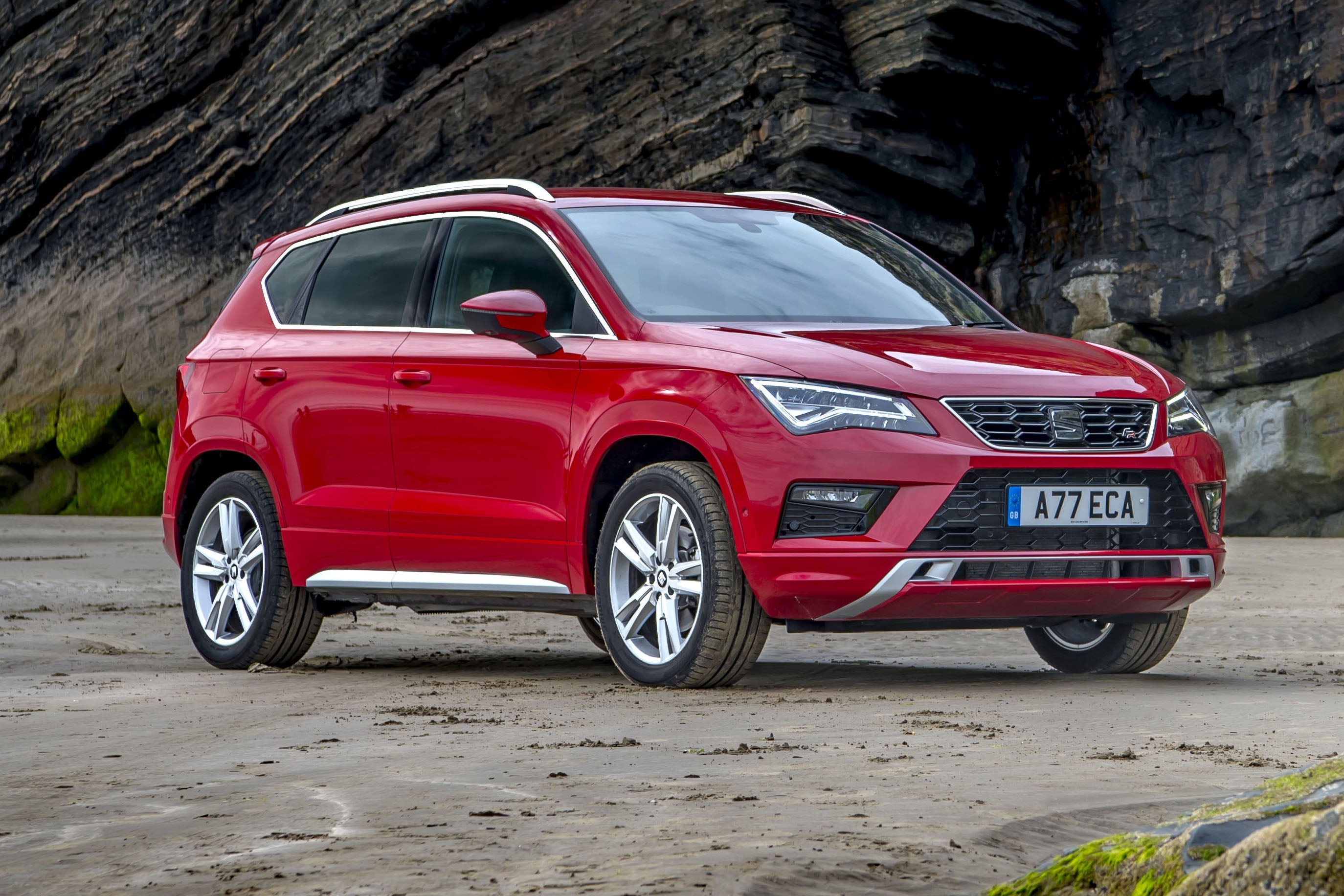Skoda Karoq Review 2024
Written by Andrew Brady
Quick overview
Pros
- Composed and easy to drive
- Solidly built and versatile interior
- Used examples represent excellent value for money
Cons
- Styling is a bit dated
- Automatic gearbox can be hesitant
- No hybrid options
Overall verdict on the Skoda Karoq
"If you're looking for a family SUV that puts comfort and practicality over pretty much everything else, the Skoda Karoq absolutely knocks it out of the park. It's available with a wide range of efficient petrol and diesel engines, as well as two- or four-wheel drive. All models are well-equipped and, providing you avoid the glitzier high-spec trim levels, none will break the bank."
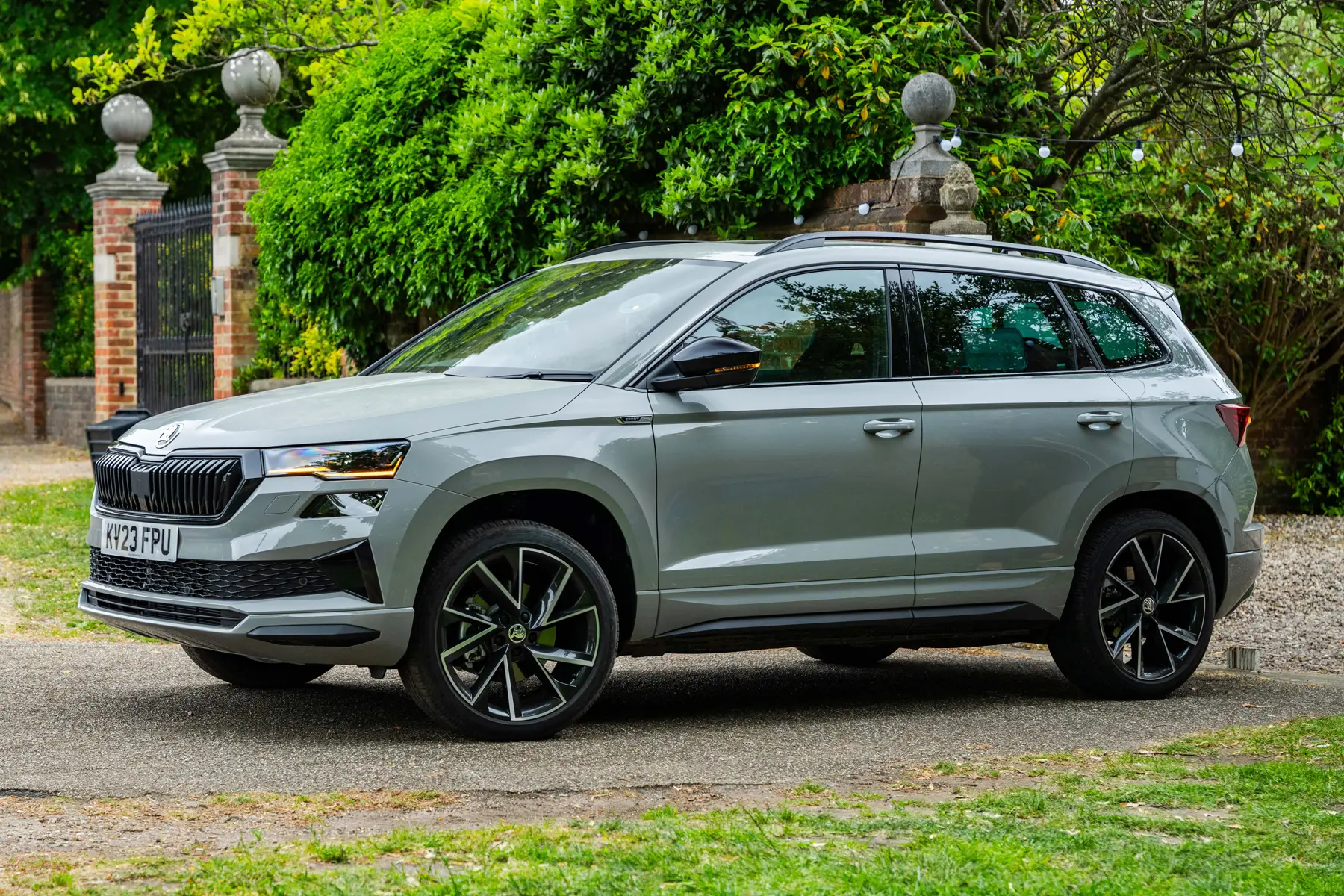
In recent years, SUVs have become the default choice for family car buyers, and your choice has never been greater or more diverse. The Volkswagen Group, for example, will sell you any one of four family SUVs based on all-but-identical underpinnings, in the form of the premium Audi Q3, the refined Volkswagen Tiguan, the sporty SEAT Ateca and the sensible Skoda Karoq. Don't go thinking that we mean 'sensible' as a negative, however. As our 2024 Skoda Karoq Review shows, it may well be the best of the bunch.
Why? Well, simply because it combines so many great family car qualities in a relatively affordable package. It was also given a mid-life refresh early in 2022, bringing updated styling, additional tech and changes to the engines and trim levels.
While the straight-laced Skoda Karoq initially took a bit of criticism for being less characterful than its predecessor, the quirky Yeti, it looks more upmarket than you'd expect from a relatively cheap SUV, and you can get stylish SportLine or rugged Scout models if you do want to stand out a bit more.
It's also more comfortable and refined than the Yeti, and has an interior that could put more expensive rivals to shame with its good quality finish, practical touches and logical layout. If you want a relaxing, sensible (and sensibly priced) SUV, the Karoq is still one of the best in the business.
The Skoda Karoq has plenty of passenger space, whether you're sat in the front or the back. And while a few rivals are better for carrying five adults, almost none can beat it for clever on-board storage or load-lugging capacity.
That's because the higher trims on the Skoda Karoq come with clever 'VarioFlex' seats (optional on lower trims). These slide and recline individually, fold down in a flexible 40/20/40 configuration and can even be totally removed to free up a van-like 1810-litre capacity. The downside is that the seats are really heavy, so you won't be taking them in and out very often. Still, knowing you have the flexibility to stack it to the roof when needed definitely adds another feather to the Skoda's cap.
Every Skoda Karoq model comes with a generous amount of equipment, including an 8.0-inch touchscreen that's up there with the best in the class in terms of ease-of-use, climate control and rear parking sensors, too. Entry-level SE trim is the best value, but even if you do feel like splashing out, the luxurious SE L trim won't break the bank, adding navigation and a bigger screen, heated seats and bright LED headlights, although top-spec cars start to get expensive. Newer 2022-on models get even more kit additions including digital dials as standard.
Most versions of the Skoda Karoq are front-wheel drive with a six-speed manual gearbox or seven-speed automatic, but you can buy the most powerful diesel and petrol variants with four-wheel drive. We like the manual, which is light and precise, but while the twin-clutch auto (optional on cheaper models) does a decent enough job, it can be a bit slow to kick down.
Kicking the range off is the modestly powerful 1.0-litre three-cylinder TSI petrol with 115PS, but there’s also a 1.5-litre that is a lot quicker (but just as efficient) and a range-topping 2.0-litre with 190PS. We think most buyers will be best off with the 1.5 TSI. It's a smooth and quiet engine, with enough urge to overtake and make relaxed progress.
On the diesel side, buyers can pick between a 1.6-litre or 2.0-litre TDI. The bigger engine is available with four-wheel drive, with either 150PS or 190PS. Both are great for towing, and can haul over two tonnes, although the 1.6 is a bit noisy at times. The Karoq also has decent off-road ability, and will happily tackle a slippery grass field or muddy country lane with no trouble.
On the road, the Karoq is really comfortable cruiser, with soft suspension and a really forgiving ride. It has accurate, confidence-inspiring steering, lots of grip and neat handling, but is not as sporty and sharp as SEAT's Ateca. Still, for the things most family buyers will prioritise, the Skoda Karoq delivers in spades, and is a great all-rounder. Yes, there are more interesting and stylish choices around these days, but honest, simple family transport doesn't get much better.
Looking for a used car for sale? We've got 100s of Skoda Approved Used Cars for Sale for you to choose from, including a wide range of Skoda Karoq cars for sale.
Is the Skoda Karoq right for you?
There's a whiff of the emperor's new clothes about small SUVs that promise practicality but fail to deliver. That doesn't apply to the Karoq, though. For buyers who genuinely need a roomy interior and proper load-lugging ability, the mid-size Skoda Karoq will be the perfect workhorse.
The Karoq's clever removable seats, massive boot and generous passenger space mean it will cope with the rigours of family life far better than a standard five-door hatch, plus it comes with the option of four-wheel drive should you need it.
It's no one trick pony though. A surprisingly posh interior, generous level of equipment and very comfortable, easy-to-drive nature make the Skoda Karoq feel competitive even with newer, fresher family SUVs.
Avoid the slightly underpowered 1.0-litre petrol and noisy 1.6-litre diesel, and it's a strong performer, too. But if you are the kind of buyer who wants to turn heads with your SUV, then the Karoq's generic exterior and conservative cabin might not scratch that itch.
What other cars are similar to the Skoda Karoq?
There's no shortage of talented compact SUVs capable of matching the Skoda Karoq's usability and rugged image. Pick up a Peugeot 3008 or Mazda CX-5 if you want a dash of style with your practical five-door SUV, and both are talented elsewhere.
The latest Nissan Qashqai is also a solid all-round choice, while the Ford Kuga and Vauxhall Grandland are also worth considering. We can't ignore the stylish and generously-equipped Hyundai Tucson and Kia Sportage, though, particularly with their longer warranties than rivals.
From the Volkswagen Group, sister cars the SEAT Ateca and Volkswagen Tiguan are two sides of the same coin. Get the former for a keen price and tidy handling, while the latter has a plusher ride and a slightly better finished interior.
Buyers who want to push the boat out a little with a premium alternative should try the smart and spacious Volvo XC40, or if you are more interested in muddy fields than modern architecture, a Range Rover Evoque.
Those on a tighter budget should consider looking at the smaller Skoda Kamiq or Citroen C3 Aircross. The latter is very efficient for an SUV, and surprisingly spacious inside despite being a lot shorter than the Karoq. For really low running costs or company car buyers, the efficient petrol-electric Toyota C-HR is a fine, if slightly compromised, choice.
Comfort and design: Skoda Karoq interior
"Skoda has taken a sensible, logical approach to designing the cabin of the Karoq. The good news is it gets the basics all spot-on, and is fantastically easy to get on with."
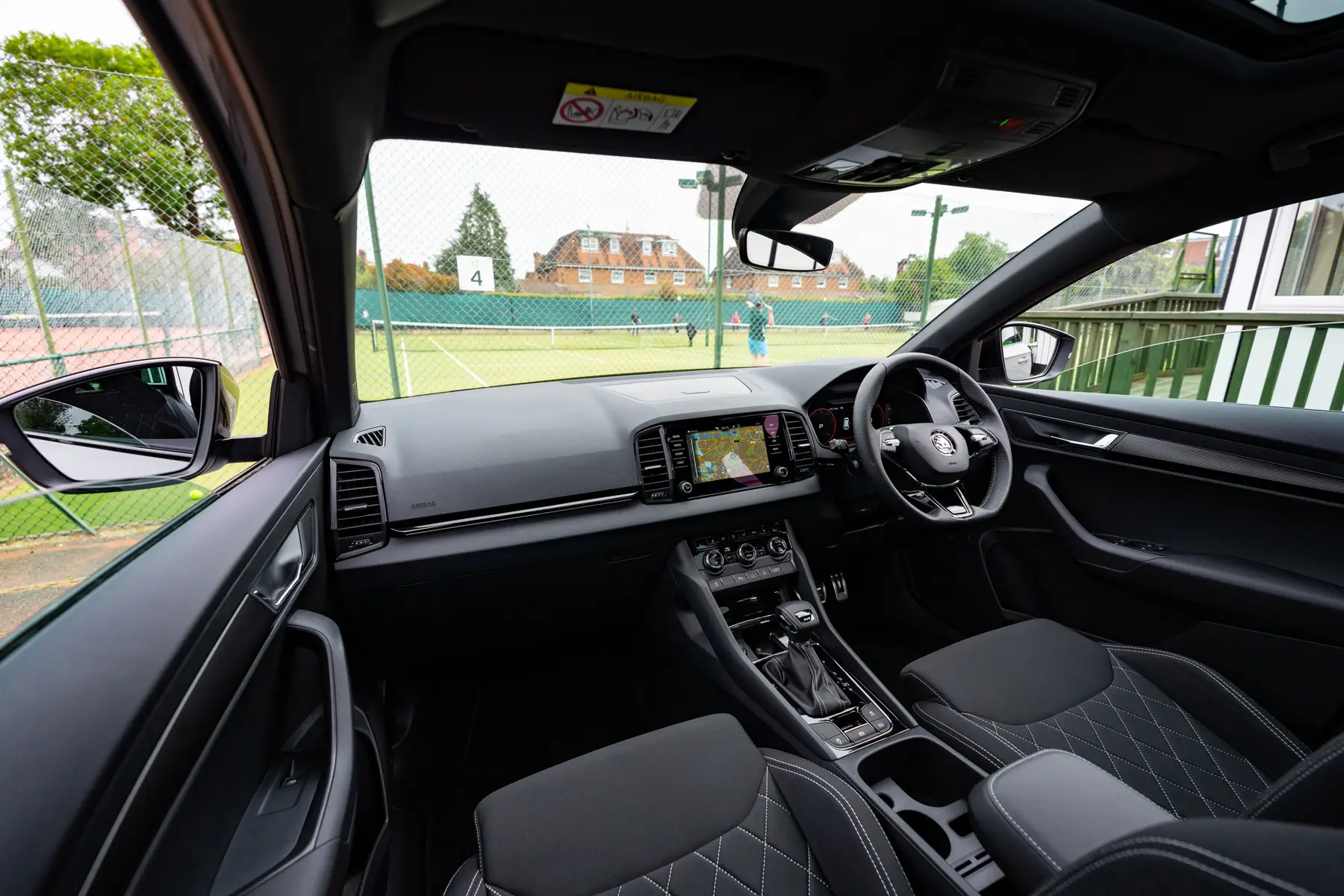
It goes without saying that the Skoda Karoq has a raised driving position that gives a great view of the road ahead, but another bonus is excellent all-round visibility thanks to a low dashboard, flat windscreen and thin pillars. It never feels daunting to manoeuvre around a tightly-packed multi-storey or reverse into a tricky parking spot.
No matter what your build, you'll be able to find a comfortable position in the supportive front seats of the Skoda Karoq. They get height adjustment and lumbar support across the range, plus you can move the steering wheel in a wide arc. Pricier trims have seat heaters, while the top-spec models come with electric adjustment for more fine tuning. SportLine trim gets cool-looking and supportive sports seats, although they restrict the view from the rear seats a little.
The layout of the Skoda Karoq's interior is more conventional than what you'll find in style-led rivals such as the the Peugeot 3008, but all the controls are logically placed and clearly labelled. There is nothing to confuse or irritate here, which can't be said of some rivals. Arguably a stress-free and simple cabin layout is of high importance to parents of small children.
Stick with the standard 8.0-inch touchscreen if you want something simple to use as it has more physical controls and shortcut buttons than the upgraded unit. Luckily, both keep the climate dials totally separate from the display, a major plus compared with cars that force you to use the screen to adjust the temperature.
Our only minor gripes with the Skoda Karoq's interior are with the dials, which feature a silver ring around the rev counter and speedo that makes them harder to read at a glance due to glare in sunlight. Happily, examples produced after the 2022 facelift, fixed this with configurable digital instrument dials as standard.
Quality and design
The Skoda Karoq may have borrowed heavily from the Kodiaq when it comes to cabin layout, but it also copied the excellent material quality and high level of fit-and-finish that make its big brother feel so smart and solid.
With such a conservative - some would say unexciting - design, the Skoda Karoq could so easily feel dreary inside, but the bright flashes of metallic trim around the air vents and steering wheel spokes, plus the glossy piano black centre console, do manage to add a touch of class.
Areas you'll come into contact with regularly are draped in soft-touch materials and any harder plastics are hidden far from view - not that you'll find too many of them. All the controls on the Skoda Karoq operate with slick precision. Overlapping panels leave tiny gaps between them and nothing creaks or spoils the upmarket appearance. It not only looks good, it feels robust enough to cope with daily abuse.
The LED lighting in Skoda Karoq SE Drive models bathes the cabin in a soft red glow, but things don't drastically change as you travel up the range. The seat fabrics get progressively nicer, going from fabric, to suede and then leather, while the Scout versions have some questionable faux wood inlays, but all feel high quality to sit in.
Infotainment: touchscreen, USB, nav and stereo in the Skoda Karoq
Staying connected on the move is no hassle inside the Skoda Karoq. Even SE models come with a bright 8.0-inch touchscreen set into the centre of the dashboard, with standard Bluetooth, DAB radio and smartphone mirroring in the form of Apple CarPlay and Android Auto.
The latter means the system will play nice with Apple and Android phones, allowing you to plug in and access most of your apps via the built-in display, which is the safest way to use your phone while driving.
Using the screen is very intuitive on the Skoda Karoq. There are large on-screen icons that are easy to hit on the move, it has snappy responses to your inputs and touch-sensitive shortcut buttons if you happen to get lost in the menus. Upgrade to SE Drive and you get an integrated navigation system that's quick at route planning, coming with on-board WiFi and live traffic updates, but since you can just use Google Maps or Waze via your phone connection, the SE does fine without it.
The pricier SE-L, Sportline and Edition trims come with an upgraded 9.2-inch screen with sharper graphics and basic gesture controls, so you can swipe in the air to scroll through radio stations or albums. It looks smart enough, but is harder to use than the normal setup, with no volume knob, and just one row of buttons on the wrong side for the driver.
It's also possible to replace the normal instruments with a digital screen that can show a wider range of driver information and works with the nav so that you only need to glance down to see which turn you're taking. This was an option on pre-facelift models but comes as standard across the range from 2022.
The standard eight-speaker sound system is decent enough but a touch weedy at times, so the upgraded ten speaker system is a good option to look at.
Space and practicality: Skoda Karoq boot space
The Skoda Karoq's dimensions are actually surprisingly compact for the space on offer. It's 4282mm long, 2025mm wide (including the door mirrors) and 1603mm tall. Its footprint is essentially the same as a Volkswagen Golf's, although its 178mm ride height will come in handy on those occasions when you need increased ground clearance.
Where some compact SUVs flatter to deceive with their rugged looks but cramped interiors, this car offers a proper level of versatility and spaciousness that you simply won't find in any run-of-the-mill family hatchback.
Largely, that's down to the ingenious VarioFlex seats. Standard from the Karoq SE L upwards - and optional on the cheaper models - they replace the rear bench with three individual chairs that can slide to trade legroom for boot space, recline, fold, or be taken out entirely. This gives the Karoq interior flexibility that's simply unrivalled in this class.
This means that if you've only got small kids in the back (but a lot of luggage) you can pull the seats forward, leaving a massive 588-litre loading space for their kit and caboodle in the boot. Even set in the farthest back position, the Skoda Karoq's boot can still carry 479 litres worth of stuff, or a whopping 1810 litres if you take them all out.
So, if you're moonlighting as a removals service, it's hard to beat,then. But what about more mundane tasks? Well, the boot isn't just enormous, it's smartly designed, too. There are a plethora of hooks and lashing eyes designed to help prevent your groceries from rolling around, plus a removable torch for night time pit stops.
The rear doors open up very wide, which means fitting a child seat should pose few issues, especially as the passenger space is as generous as the boot. Taller passengers will still have a couple of inches of leg room and even with a cumbersome rear-facing child seat in the back row, you'll be able to fit a passenger up front.
It feels like there are more storage solutions in this Skoda Karoq than half an IKEA catalogue. Along with supersize versions of the usual spots under the central armrest, the glovebox and door pockets, there's a huge cubby perfect for stashing valuables built into the dash, along with two neat picnic tables (with drinks holders) in the back.
That's before you factor in the umbrella stashed under the front passenger seat, plastic ice scraper hidden in the fuel filler cap, parking ticket holder in the windscreen and cupholders that have a grippy base, allowing you to open a bottle with just one hand.
Handling and ride quality: What is the Skoda Karoq like to drive?
"With many SUVs, the combination of raised suspension, big wheels and extra weight all conspire to make them feel a bit lumpen in corners and too stiff to be comfortable family transport. Not so in the Skoda Karoq."
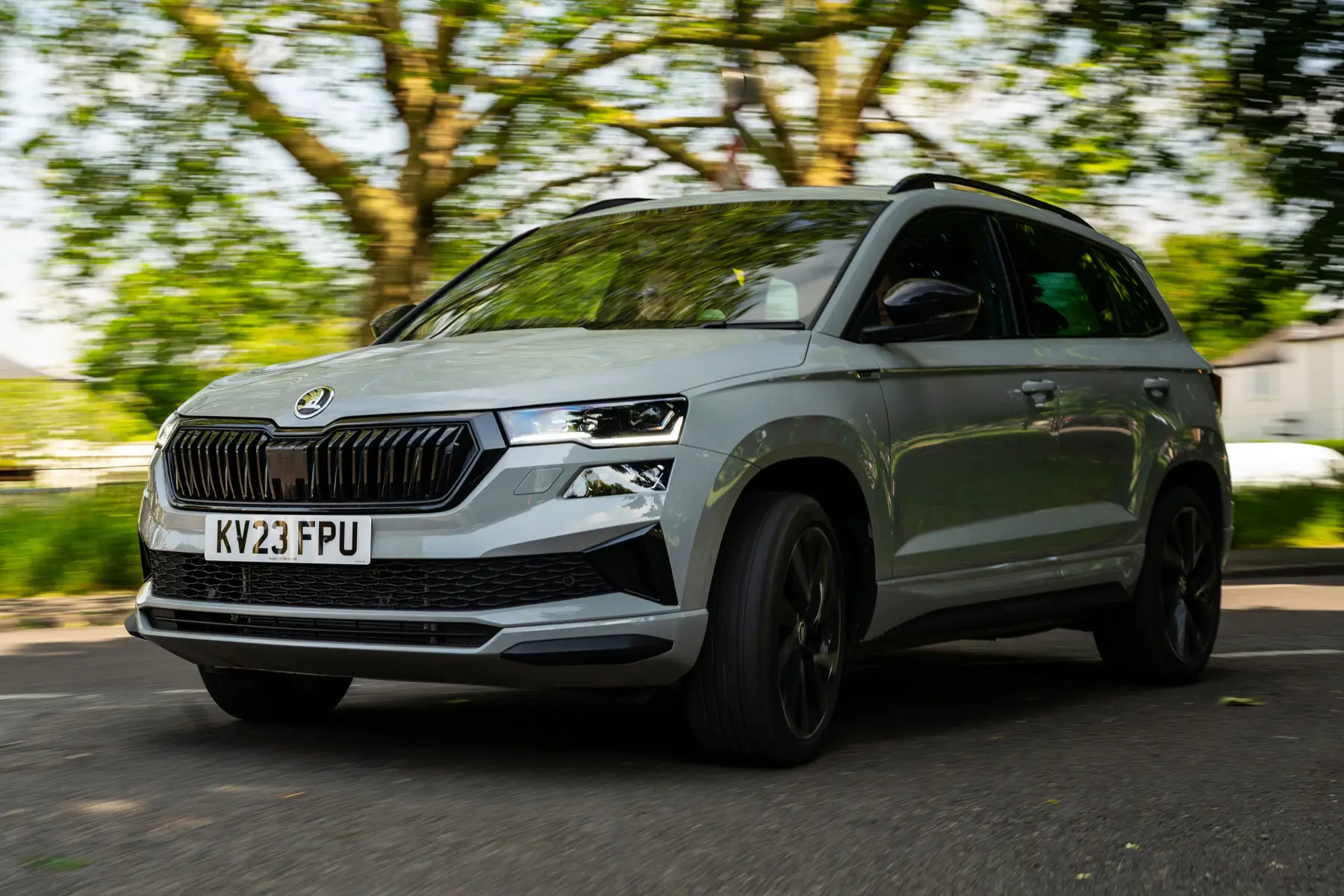
The Skoda Karoq is one of the most comfortable cars in this class, doing an excellent job of smothering any lumps in the road. That's especially true if you stick to models with smaller wheels, which glide over imperfections with zero fuss.
That's great for town driving, where the Karoq feels very manageable to drive. The steering is precise and the suspension delivers has good body control, which means it doesn't float over big bumps or lean too heavily into tighter corners. While some rivals (including its sibling the Ateca) do feel sportier to drive, many will prefer this relaxed setup because the Ateca can feel firm at times.
Pick the Karoq in Sportline trim - with its 19-inch rims - and you might want to think about adding the optional adaptive dampers, too, as this version definitely transmits more of the road surface into the cabin than the standard car. The optional dampers allow you to tighten up or slacken off the suspension at the press of a button, taking the edge off of the ride.
On more open and flowing roads, the Karoq acquits itself admirably, especially when you consider that it isn't trying to be even remotely sporty. The body rolls a tad more than some rivals as you turn into a bend, but this never feels unsafe, with loads of grip from the tyres (especially with four-wheel drive) giving you confidence.
Speaking of the latter, should you wish to do a little light off-roading, the Karoq should be up to the task, just like its predecessor the Yeti was. Every 4x4 model comes with hill descent control to help you tackle steep, slippery inclines safely, plus an off-road driving mode, and you can also add extra underbody protection. That said, the two-wheel drive models will still be capable of getting down a rutted track.
What engines and gearboxes are available in the Skoda Karoq?
The Skoda Karoq is not offered with a hybrid or electrified option (unlike the Ford Kuga or Hyundai Tucson) so your choice is limited to a range of conventional diesels and petrols. This is a bit disappointing in 2024, but rest assured that the next-generation model will have some sort of hybrid option.
A six-speed manual gearbox is standard on most variants, with the option of fitting a fairly slick dual-clutch automatic. Both do a fine job, although like with other VW Group products, there can be a bit of a delay with the automatic when you're trying to pull smartly out of a junction or overtake.
The entry-level engine is a 1.0-litre three-cylinder petrol turbo with 115PS (later reduced even further to 100PS) that frankly, feels a bit too small for this type of car. It makes a characterful noise and revs eagerly, but this song and dance is not accompanied by a lot meaningful forward momentum. It'll struggle when the car is fully loaded, going uphill or overtaking, though if you're just pottering about town it'll do the job.
By contrast, the 1.5-litre petrol with 150PS is a really nice alternative to diesel. It's got enough pulling power to feel urgent, even from low revs, is really refined and can shut down half of its cylinders to help save fuel. Unless you plan on using your Karoq for towing, or drive very high mileages, this is the one we would go for.
Of the three diesels, the 2.0-litre 150PS car is the sweet spot in the range. The cheaper 1.6 TDI feels a little strangled by its narrow power band, making more of a diesel clatter at low revs. It was later replaced with a 116PS version of the 2.0-litre, which we've never had the opportunity to try. The 150PS engine comes with a choice of front- or four-wheel drive, but pick the latter and you're limited to the automatic gearbox.
On top trims this engine comes with more power, boosting its outputs to a healthy 190PS and 400Nm. Great for hauling a heavy load, but the standard 2.0-litre feels pretty stout already, so we wouldn't bother. Many buyers agreed, and this engine didn't sell awfully well as a result, and so was later phased out of the range.
For buyers who want a wolf in sheep's clothing, there's a 2.0-litre TSI petrol with four-wheel drive and 190PS to match the fastest diesel. It's smooth and rapid, but only available in Sportline trim and pretty thirsty on fuel.
Refinement and noise levels
The mature and sensible way that the Karoq goes about its business extends to how it deals with cabin noise. It does a nice job of isolating you from the outside world and you won't feel drained after a few hours of driving.
At motorway speeds there's a little more wind rustle than in, say, a Hyundai Tucson, but tyre noise fades right into the background especially on sensible wheels, and most of the engines will rarely disturb the tranquility.
We say - most - because there are exceptions. The 1.5 TSI is the smoothest motor of the bunch, especially around town, but at higher revs it can sound strained. Pick the 1.0-litre three-cylinder, though, and you'll hear (and feel) the engine more often. It's not unpleasant, but can be quite vocal, sending a light buzz through the controls.
Pick any of the diesels with the Skoda Karoq and you won't have to use the gears as often. They'll settle into a hushed cruise, but they can be rather gruff at low revs, especially the 1.6-litre model. Shifting with the manual gearbox is a light and precise process, but the optional twin-clutch automatic can be a bit abrupt, lurching forward when parking.
Safety equipment: How safe is the Skoda Karoq?
Family buyers that have fallen in love with compact SUVs like the Karoq are some of the most demanding when it comes to vehicle safety. Luckily, the Skoda got the maximum five-star rating from crash testers Euro NCAP.
That puts it in-step with other heavy hitters in this class, including the Nissan Qashqai, Hyundai Tucson and Peugeot 3008. A closer look at the individual categories, though, shows the Karoq's 79% rating for child protection isn't quite as good as the class best.
Perhaps that's because even on the priciest trims, rear curtain and rear side airbags are optional extras. In most other respects the Skoda Karoq has a decent roster of electronic safety nets and protective equipment. All models come with automatic emergency braking (AEB) that can intervene to prevent low-speed city shunts.
Every trim apart from the entry-level SE gets parking sensors, while SE L comes with a reversing camera to help negotiate tight parking spaces or back into the garage without knocking a tin of paint over.
Still, where some rivals (Toyota's C-HR for example) provide a traffic sign recognition system, lane departure warning, and adaptive cruise control across the range, in the Karoq these are all optional extras.
If you're a nervous driver and want as much help as possible, the Driver Assistance Pack on the Skoda Karoq is there to help you. This comprehensive bundle includes most of what we mentioned above, plus blind spot detection to alert you to motorbikes and a semi-autonomous systems that can steer, stop and accelerate by itself in traffic jams.
The latter system only works on automatic models, but the pack is reasonably priced. A cheaper option worth considering is an extra set of ISOFIX mounting points on the front seat.
MPG and fuel costs: What does a Skoda Karoq cost to run?
"According to the figures conducted under the WLTP test regime, the most efficient Karoq models are those with the 1.6-litre TDI engine, paired with a manual gearbox. It's the only model in the range capable of over 50mpg."
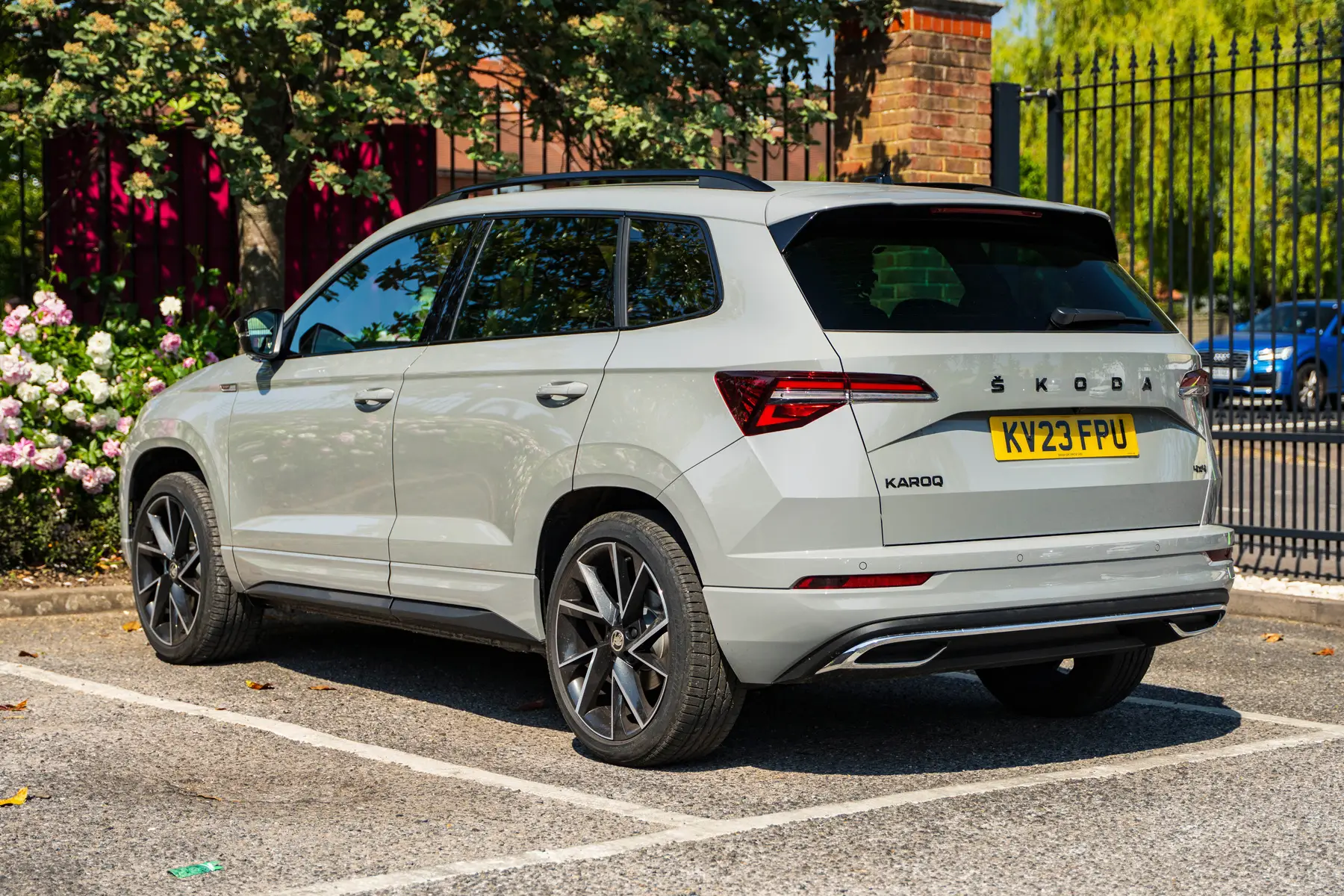
Skoda Karoq owners back that up, with a combined average of 50mpg for this engine, on a mixed route. Weirdly, the official stats are identical for the front-wheel drive 2.0-litre diesel. Still, our experience suggests a realistic 45mpg with the larger engine.
In 2022 that 1.6-litre diesel was dropped and replaced with a detuned 2.0-litre TDI unit offering similar power. Interestingly, that's noticeably more efficient on paper, managing up to 59.3mpg combined. the 150PS version officially managed 57.7mpg combined, although you'll probably only see that on a long run. Adding four-wheel drive and an automatic will put a dent of around 8mpg into that officially, though it may be less in the real world.
As for the petrols, the 1.5 TSI manages 46.1mpg with a manual gearbox and ever so slightly less with the automatic. The 1.0 TSI gets 48.5mpg on paper, with the 2.0 TSI quite thirsty at 38.7mpg.
How reliable is the Skoda Karoq?
Skoda may have once been the butt of jokes but the modern Skoda brand has historically been the best performing make in the Volkswagen Group when it comes to reliability and owner satisfaction. Need proof? Well Skoda placed second in the 2020 HonestJohn.co.uk Satisfaction Index, behind only Lexus.
It's dropped to the mid-table in the 2022 Satisfaction Index in 13th, however, although that's still better than all VW Group brands besides Porsche.
The Skoda Karoq is proving reliable, too, and although not Skoda's best performing model in the Index (that would be the Superb), the small SUV still scored highly. The one fly in the ointment here is a reported issue with the 1.5 TSI that were common across Volkswagen Group models. However, Skoda says this has now been sorted to prevent the 'kangarooing' that owners were experiencing, and we have not had any recent reports.
Insurance group and costs
Paying for your annual premiums in the Karoq should be a relatively pain-free process. It's either cheaper or right in-line with most of its compact SUV peers, with the least powerful 1.0 TSI sitting in insurance group 10.
A basic SEAT Ateca is a little cheaper with the same engine (group 8) so is a better choice for those looking to insure a young driver on their policy. Our preferred engine is only a few notches higher up, in group 14.
For diesel buyers the 1.6 TDI will be just as affordable as the 1.0-litre petrol. The front-drive 2.0 TDI 150 will cost a tad more in group 16, but strangely adding four-wheel drive to this engine drops it down two bands.
VED car tax: What is the annual road tax on a Skoda Karoq?
There are no hybrid or electrified versions of the Karoq, so every used model is liable for the same standard annual £165 flat-rate of road tax (VED) that applies to all petrol and diesel cars costing less than £40,000 when they were new.
However, the first year rate for new buyers in 2024 depends on which engine you pick, ranging from £255 for the base petrol to a whopping £1,040 for the 2.0 TSI and 2.0 TDI.
However, if you happen splash out on one of the high-end versions and splash out on a few options to push the asking price over the £40,000 barrier, then you'll also have to pay a 'Premium' surcharge of £355 for the first five years.
With big diesel surcharges for company car buyers, the most affordable option for this group is going to be the 1.0-litre TSI, which is still in the fairly high 31% BIK bracket.
How much should you be paying for a used Skoda Karoq?
"Buying a used Skoda Karoq is a great way to get an even better deal off new prices, which range between £28k and £41k. It's been on sale for a few years now, so you'll find some decent bargains around.
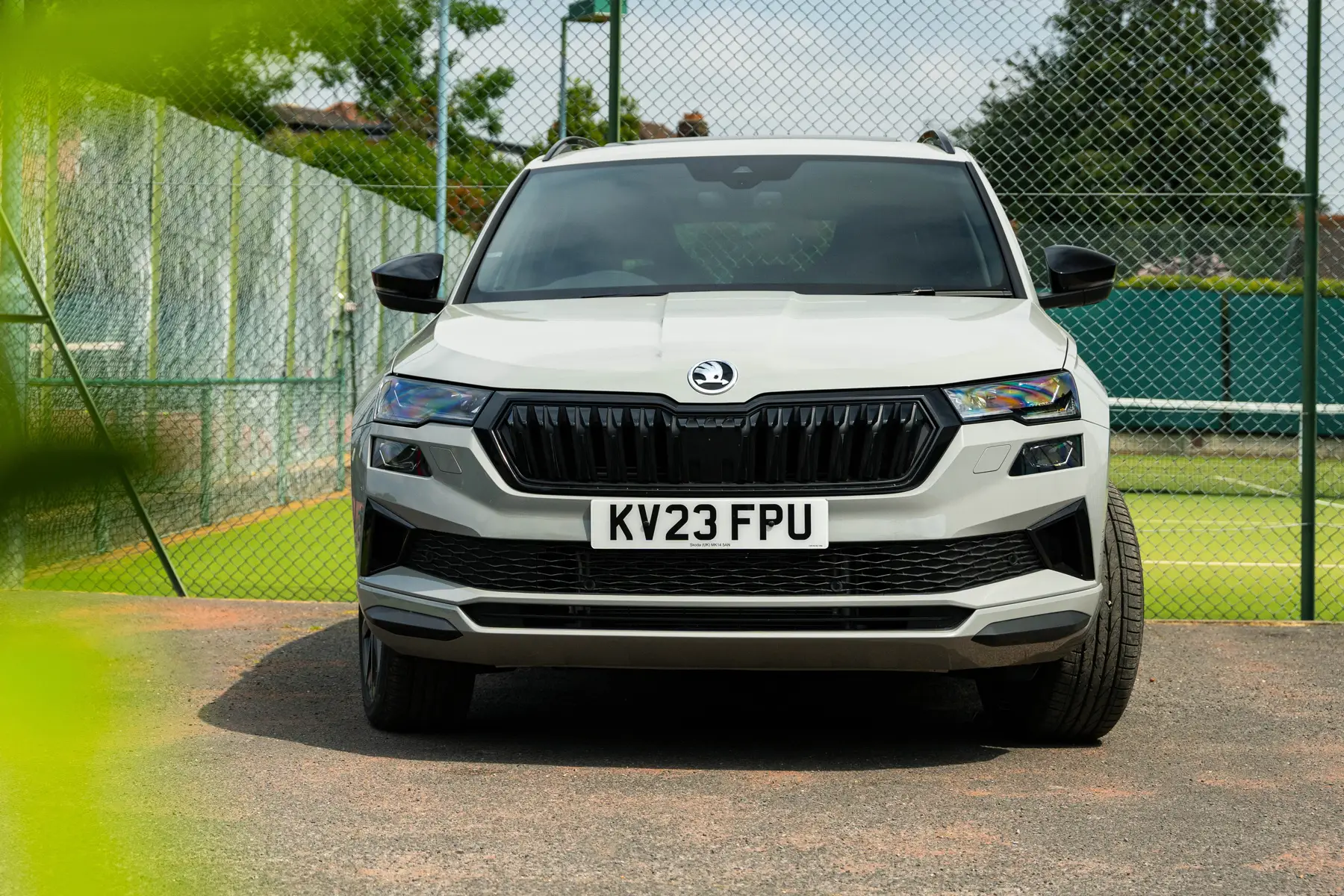
You'll need at least £11,000 to get behind the wheel of a Skoda Karoq. At that price, it'll almost certainly be from 2018 or 2019, powered by the 1.0-litre petrol engine or 1.6 TDI, and in the entry-level SE specification with at least 70,000 miles.
For one of our preferred engines, up the budget to between £14,000 and £16,000. You'll get a wider choice of trims and cars with manual or automatic transmissions, including our favourite 1.5-litre 150PS petrol.
If you want a Karoq with four-wheel drive, then SE models start from around £15,000 for a 2019 example. Facelifted 2022 versions of the Karoq start from around £21,000.
Trim levels and standard equipment
The Skoda Karoq's trim levels have changed a bit in the years since it went one sale There were four main grades at launch with a hierarchy: SE, SE Drive, SE L, and sat at the top of the pyramid was the Karoq Edition.
In 2022 the range was tweaked, starting with the SE Drive, rising to SE L and Sportline trim. The pricey Scout and Edition versions were dropped.
The Skoda Karoq Edition is the money-no-object Skoda. Predictably enough, it's not the one we'd recommend unless you find a good deal used. Luckily, most buyers won't have to scale those heady heights. The entry-level SE comes with climate and cruise control, rear parking sensors and lumbar support.
The Czech brand made a name for itself by offering great value, but it's not longer a budget option. There is no cheap-as-chips 'S' version of the Karoq. One rung up, the Skoda Karoq SE Drive has colourful LED interior lights, brushed chrome trim, a reversing camera and sat-nav, while the SE L models get suede upholstery, heated front seats, LED headlights and keyless entry and start.
Top spec Skoda Karoq Editions feature an upgraded 9.2-inch central screen, with integrated in-car WiFi, gesture controls and extra driving aids, plus the option to swap the conventional dials for a digital driver’s display.
The last two grades, Skoda Karoq Scout and Skoda Karoq Sportline, are more like standalone models. Separating themselves visually from the other cars, with bespoke bumpers and tweaked styling.
The Scout gets a tougher off-road biased look that includes scuff plates, extra plastic protective side skirts and is only available with four-wheel drive. With both models, you're mainly paying for the looks. For buyers on a budget, the SE is a great choice, but we'd recommend the SE L, mainly for its clever VarioFlex seats.
In 2022 those trim levels altered slightly, with more standard equipment available lower down the range. All models received digital dials, for example, although the upgraded 9.2-inch screen is now an expensive option because Edition trim has been deleted.
Ask the heycar experts: common questions
How much boot space does the Skoda Karoq have?
Is the Skoda Karoq reliable?
Is the Skoda Karoq a 4x4?
What does Karoq mean?
Is the Skoda Karoq a seven seater?
Stay up to speed with great offers plus the latest car news and reviews
Keep me updated by email with the latest advice, news and offers from heycar.
By submitting you agree to our privacy policy


